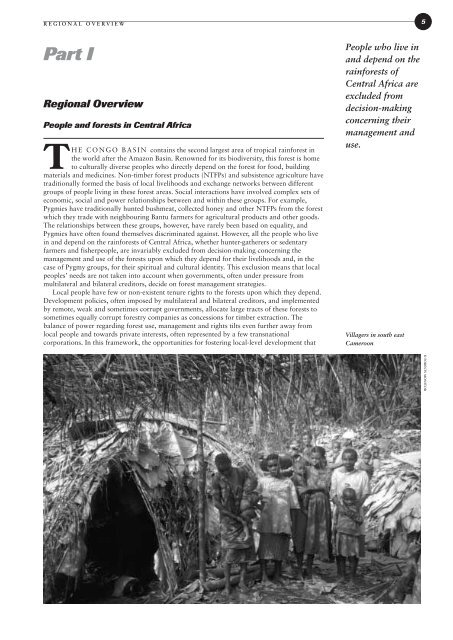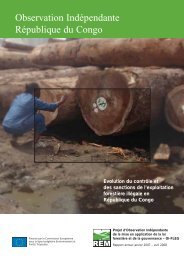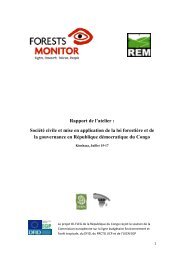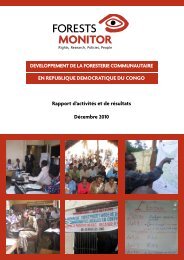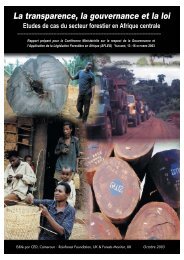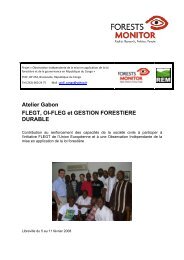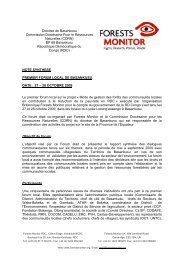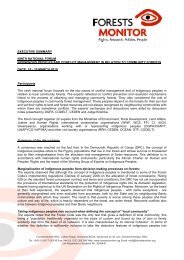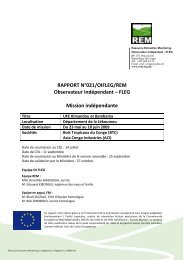4SOLD DOWN THE RIVERIntroduction© FORESTS MONITORThe six Central Africancountries featured in thisreport – Cameroon, CentralAfrican Republic, Congo(Brazzavil<strong>le</strong>), DemocraticRepublic of Congo,Equatorial Guinea andGabonLogging trucks inCameroonTHE COUNTRIES OF THE Central African region, through which <strong>the</strong> hugeCongo River and its tributaries flow, are rich in natural resources – oil, diamondsand o<strong>the</strong>r minerals, as well as forests. But despite this wealth, <strong>the</strong> countries’ peop<strong>le</strong>sare among <strong>the</strong> poorest in <strong>the</strong> world and <strong>the</strong>ir governments remain deeply indebted tomultilateral institutions and <strong>the</strong> former colonial powers.The six Central African countries featured in this report – Cameroon, Central AfricanRepublic, Congo (Brazzavil<strong>le</strong>), Democratic Republic of Congo, Equatorial Guinea and Gabon– all contain large expanses of rainforest that have provided livelihoods, building materialsand medicines to millions of forest-dependent peop<strong>le</strong>s. These countries’ governments, oftenunder strict structural adjustment and liberalisation policies imposed by multilateral andbilateral creditors, are promoting industrial timber exploitation in most of <strong>the</strong>ir forest areaswhilst local peop<strong>le</strong> have no opportunities to participate meaningfully in deciding how best touse forest resources. Although governments and creditors actively promote transnationalprivate investment in <strong>the</strong> forestry sector, <strong>the</strong>y have done litt<strong>le</strong> to establish a framework forcontrolling <strong>the</strong>se private interests. Forestry and environment laws, which provide a minimumoperating standard, are often unc<strong>le</strong>ar and are rarely enforced. This has <strong>le</strong>d to forest policiesthat, on <strong>the</strong> one hand, undermine <strong>the</strong> livelihoods and increase <strong>the</strong> insecurity of local peop<strong>le</strong>swhilst, on <strong>the</strong> o<strong>the</strong>r, facilitate <strong>the</strong> dominance of unaccountab<strong>le</strong> corporations.Transnational companies should not separate <strong>the</strong>ir operations from <strong>the</strong> broader politicalframework within which <strong>the</strong>y operate. Political conflicts within countries add to <strong>the</strong>difficulties of operating <strong>the</strong>re and also throw up ethical di<strong>le</strong>mmas about direct or indirectsupport for repressive regimes and factions. Timber sector revenues may fuel conflict directly,as has happened in Liberia and Cambodia. If logging advances into areas of existing conflictwithin <strong>the</strong> Central African region, political, social and economic prob<strong>le</strong>ms will be exacerbated,particularly if <strong>the</strong> preva<strong>le</strong>nt haphazard and il<strong>le</strong>gal forestry practices continue. Insecuritygenerated by unsustainab<strong>le</strong> logging operations, such as loss of rights to forest resources anddeclining food availability, may also produce conflict in <strong>the</strong> longer term.Forests Monitor believes that <strong>the</strong>re should be regulatory frameworks within whichtransnational corporations operate, both in <strong>the</strong> countries of operation and in <strong>the</strong> countrieswhere <strong>the</strong>y are headquartered, that foster accountability and that put <strong>the</strong> needs and rights offorest-dependent peop<strong>le</strong>s at <strong>the</strong> heart of <strong>the</strong>ir actions. Increasingly, civil society in Africa isfinding a voice to speak out against human rights abuses, <strong>the</strong> burden of debt andenvironmental degradation. Such movements should be supported so that <strong>the</strong>y can play anincreasing ro<strong>le</strong> in defining and establishing equitab<strong>le</strong> development goals that respect forestdependentpeop<strong>le</strong>s’ livelihoods and know<strong>le</strong>dge.This report examines <strong>the</strong> political, social and economic context for forest managementpolices in each of <strong>the</strong> six Central African countries and focuses on <strong>the</strong> transnational loggingcompanies headquartered in <strong>the</strong> European Union (EU) that operate <strong>the</strong>re. The reasons for thisfocus are three-fold. Firstly, <strong>the</strong> EU continues to play an important ro<strong>le</strong> politically andeconomically in Central Africa,directly and indirectly shaping forestdevelopment and conservationpolicies. Secondly, EU-based loggingcompanies continue to be significantplayers in <strong>the</strong> forestry sector of <strong>the</strong>region, controlling most of <strong>the</strong> loggingconcessions and processing plants andplaying an active ro<strong>le</strong> in internationalfora on forest management in <strong>the</strong>region. Thirdly, <strong>the</strong> EU continues tobe <strong>the</strong> primary destination for exportsof timber products from <strong>the</strong> region.For <strong>the</strong>se reasons, EU member states,and <strong>the</strong> multilateral institutions ofwhich <strong>the</strong>y are a part, can and shouldplay a strategic ro<strong>le</strong> in establishingsustainab<strong>le</strong> princip<strong>le</strong>s by which EUheadquarteredcompanies shouldoperate.
REGIONAL OVERVIEW 5Part IRegional OverviewPeop<strong>le</strong> and forests in Central AfricaTHE CONGO BASIN contains <strong>the</strong> second largest area of tropical rainforest in<strong>the</strong> world after <strong>the</strong> Amazon Basin. Renowned for its biodiversity, this forest is hometo culturally diverse peop<strong>le</strong>s who directly depend on <strong>the</strong> forest for food, buildingmaterials and medicines. Non-timber forest products (NTFPs) and subsistence agriculture havetraditionally formed <strong>the</strong> basis of local livelihoods and exchange networks between differentgroups of peop<strong>le</strong> living in <strong>the</strong>se forest areas. Social interactions have involved comp<strong>le</strong>x sets ofeconomic, social and power relationships between and within <strong>the</strong>se groups. For examp<strong>le</strong>,Pygmies have traditionally hunted bushmeat, col<strong>le</strong>cted honey and o<strong>the</strong>r NTFPs from <strong>the</strong> forestwhich <strong>the</strong>y trade with neighbouring Bantu farmers for agricultural products and o<strong>the</strong>r goods.The relationships between <strong>the</strong>se groups, however, have rarely been based on equality, andPygmies have often found <strong>the</strong>mselves discriminated against. However, all <strong>the</strong> peop<strong>le</strong> who livein and depend on <strong>the</strong> rainforests of Central Africa, whe<strong>the</strong>r hunter-ga<strong>the</strong>rers or sedentaryfarmers and fisherpeop<strong>le</strong>, are invariably excluded from decision-making concerning <strong>the</strong>management and use of <strong>the</strong> forests upon which <strong>the</strong>y depend for <strong>the</strong>ir livelihoods and, in <strong>the</strong>case of Pygmy groups, for <strong>the</strong>ir spiritual and cultural identity. This exclusion means that localpeop<strong>le</strong>s’ needs are not taken into account when governments, often under pressure frommultilateral and bilateral creditors, decide on forest management strategies.Local peop<strong>le</strong> have few or non-existent tenure rights to <strong>the</strong> forests upon which <strong>the</strong>y depend.Development policies, often imposed by multilateral and bilateral creditors, and imp<strong>le</strong>mentedby remote, weak and sometimes corrupt governments, allocate large tracts of <strong>the</strong>se forests tosometimes equally corrupt forestry companies as concessions for timber extraction. Thebalance of power regarding forest use, management and rights tilts even fur<strong>the</strong>r away fromlocal peop<strong>le</strong> and towards private interests, often represented by a few transnationalcorporations. In this framework, <strong>the</strong> opportunities for fostering local-<strong>le</strong>vel development thatPeop<strong>le</strong> who live inand depend on <strong>the</strong>rainforests ofCentral Africa areexcluded fromdecision-makingconcerning <strong>the</strong>irmanagement anduse.Villagers in south eastCameroon© FORESTS MONITOR


